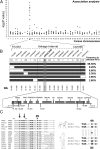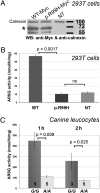A canine Arylsulfatase G (ARSG) mutation leading to a sulfatase deficiency is associated with neuronal ceroid lipofuscinosis
- PMID: 20679209
- PMCID: PMC2930459
- DOI: 10.1073/pnas.0914206107
A canine Arylsulfatase G (ARSG) mutation leading to a sulfatase deficiency is associated with neuronal ceroid lipofuscinosis
Abstract
Neuronal ceroid lipofuscinoses (NCLs) represent the most common group of inherited progressive encephalopathies in children. They are characterized by progressive loss of vision, mental and motor deterioration, epileptic seizures, and premature death. Rare adult forms of NCL with late onset are known as Kufs' disease. Loci underlying these adult forms remain unknown due to the small number of patients and genetic heterogeneity. Here we confirm that a late-onset form of NCL recessively segregates in US and French pedigrees of American Staffordshire Terrier (AST) dogs. Through combined association, linkage, and haplotype analyses, we mapped the disease locus to a single region of canine chromosome 9. We eventually identified a worldwide breed-specific variant in exon 2 of the Arylsulfatase G (ARSG) gene, which causes a p.R99H substitution in the vicinity of the catalytic domain of the enzyme. In transfected cells or leukocytes from affected dogs, the missense change leads to a 75% decrease in sulfatase activity, providing a functional confirmation that the variant might be the NCL-causing mutation. Our results uncover a protein involved in neuronal homeostasis, identify a family of candidate genes to be screened in patients with Kufs' disease, and suggest that a deficiency in sulfatase is part of the NCL pathogenesis.
Conflict of interest statement
Conflict of interest statement: INRA and ENVA have applied for a patent covering the use of the canine ARSG SNP for the diagnosis of NCL or for selective breeding of dogs. M.A. and S. Blot are listed as inventors in this application.
Figures



References
-
- Jalanko A, Braulke T. Neuronal ceroid lipofuscinoses. Biochim Biophys Acta. 2009;1793:697–709. - PubMed
-
- Berkovic SF, Carpenter S, Andermann F, Andermann E, Wolfe LS. Kufs’’ disease: A critical reappraisal. Brain. 1988;111:27–62. - PubMed
-
- Haltia M. The neuronal ceroid-lipofuscinoses: From past to present. Biochim Biophys Acta. 2006;1762:850–856. - PubMed
-
- Lewandowska E, et al. Kufs’’ disease: Diagnostic difficulties in the examination of extracerebral biopsies. Folia Neuropathol. 2009;47:259–267. - PubMed
-
- Bellettato CM, Scarpa M. Pathophysiology of neuropathic lysosomal storage disorders. J Inherit Metab Dis. 2010;33:347–362. - PubMed
Publication types
MeSH terms
Substances
Associated data
- Actions
- Actions
- Actions
- Actions
- Actions
LinkOut - more resources
Full Text Sources
Other Literature Sources
Miscellaneous

